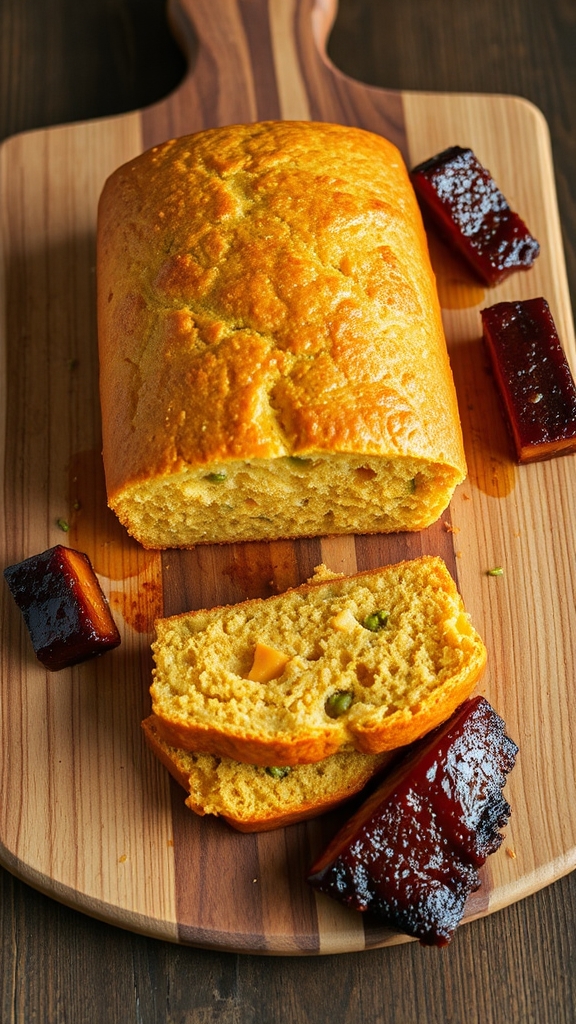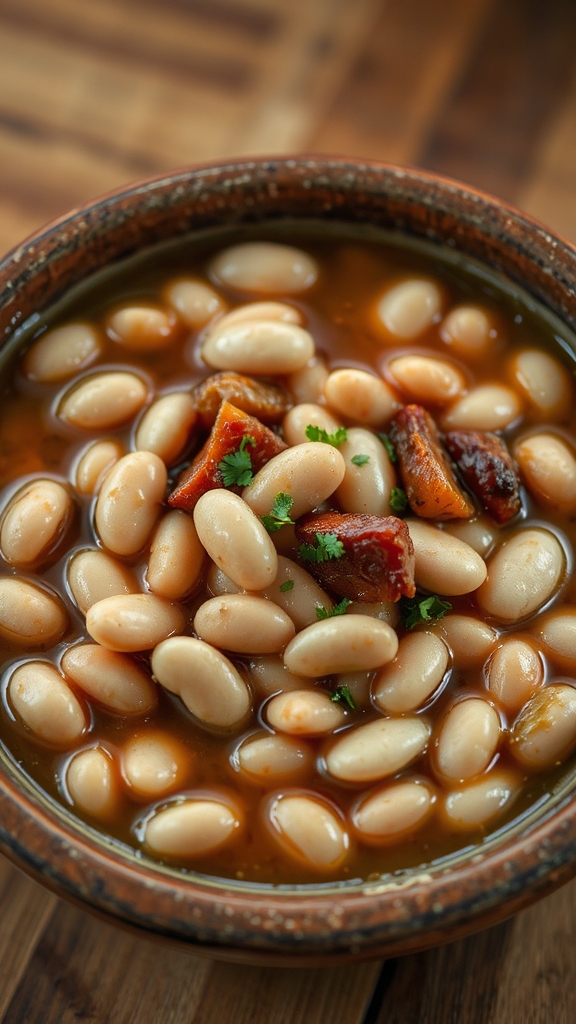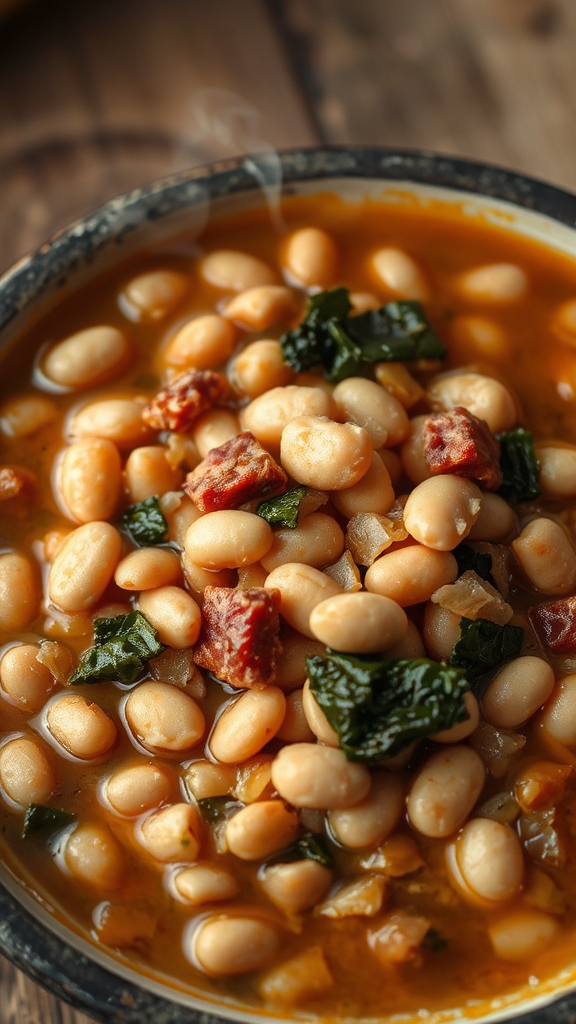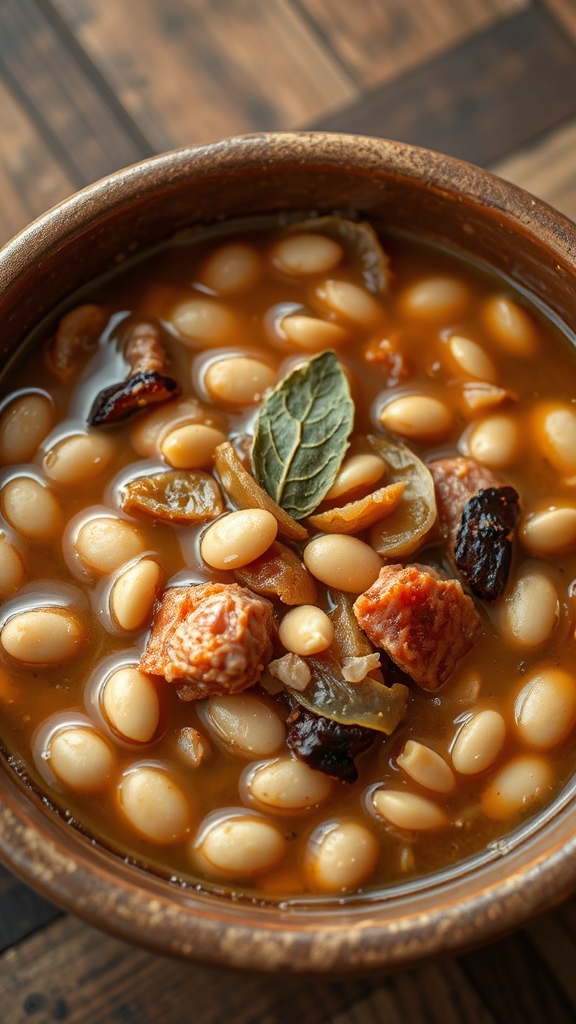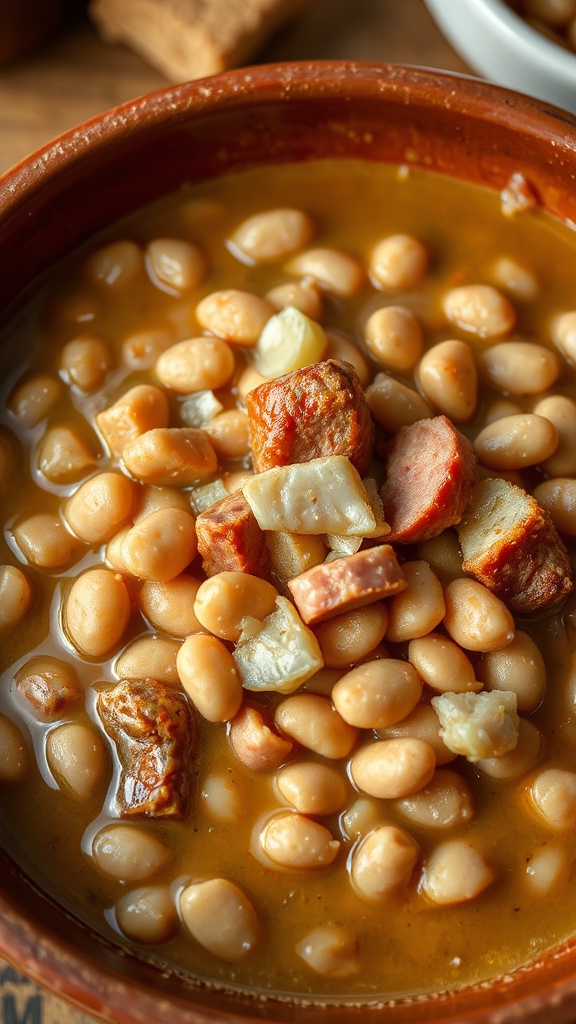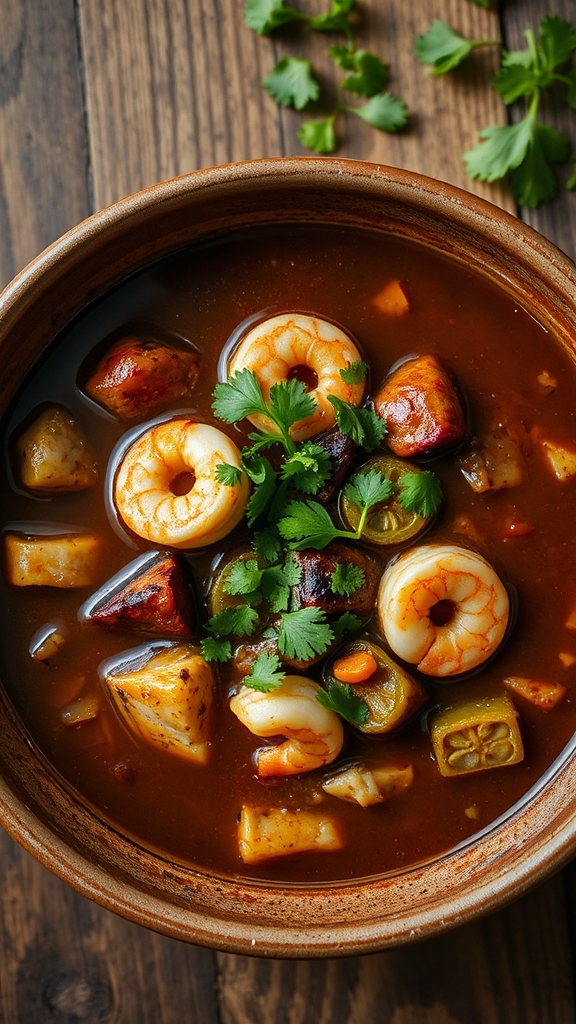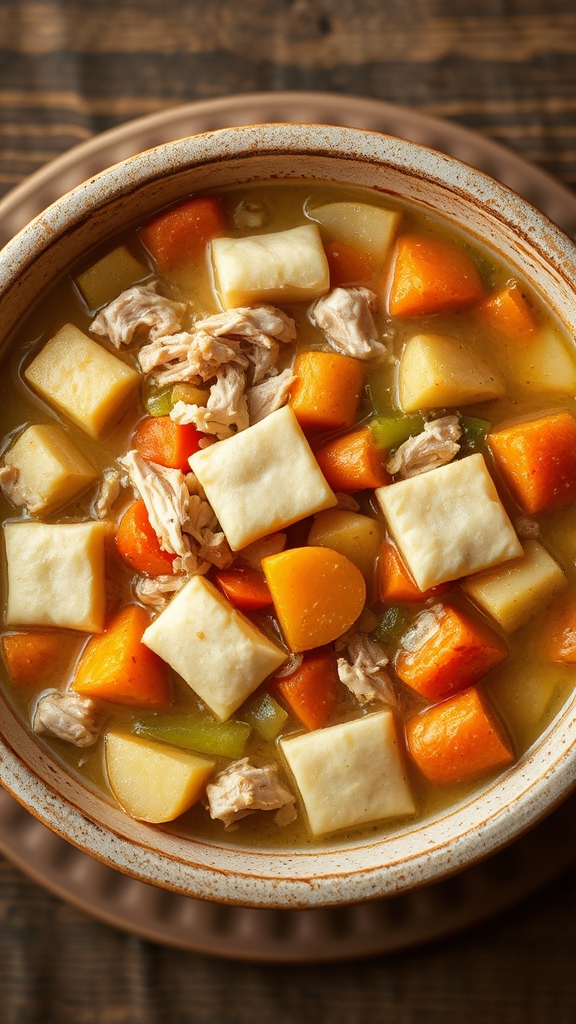Appalachian Soup Beans (Slow Cooker)
Transform your mealtime with effortless Appalachian Soup Beans in a slow cooker, revealing cozy flavors and surprising twists that await inside.
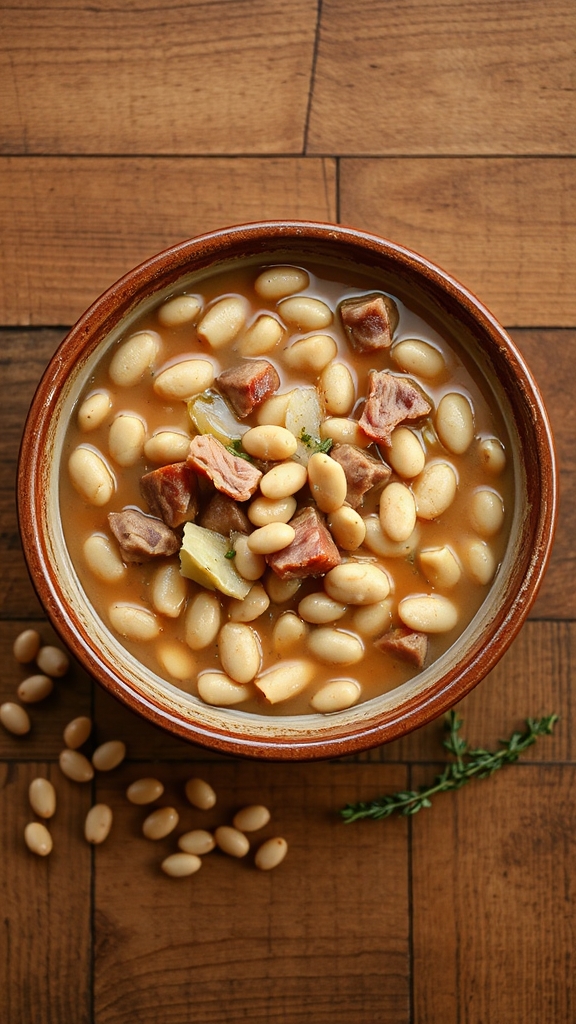
I’ve transformed the traditional Appalachian Soup Beans, inspired by Scottish, Irish, and German roots in the mountains, into an effortless slow cooker recipe. Start with 1 pound of soaked pinto beans, 1-2 pounds of ham hock, chopped onion, minced garlic, and 6-8 cups of water or broth—toss it all in and cook on low for 6-8 hours. For twists, swap beans or go vegetarian with smoked paprika. You’ll discover more variations and tips just ahead to make this your go-to comfort.
History
Appalachian Soup Beans originated in the rural Appalachian Mountains of the United States, drawing from the frugal traditions of Scottish, Irish, and German immigrants who relied on simple, affordable ingredients like dried beans for sustenance in isolated communities.
Regional variations, such as using pinto beans in the southern Appalachians or adding ham hocks in other areas, highlight local resource availability and cultural adaptations, underscoring the dish’s role in preserving family heritage and community identity.
Traditionally, it’s served as an everyday comfort food, especially during harsh winters, and on occasions like family gatherings or holidays, symbolizing warmth, simplicity, and shared meals in Appalachian culture.
Ingredients
– Dried pinto beans, about 1 pound – Oh, these are the heart and soul of Appalachian Soup Beans, aren’t they?
Start with a good pound of dried pinto beans, the kind that soak up flavors like a cozy blanket on a chilly day.
Remember, rinsing them first gets rid of any dust or debris, making everything just a bit more inviting.
– A ham hock or some smoky bacon, roughly 1 to 2 pounds – Now, who could resist that rich, porky goodness?
A ham hock adds that deep, savory depth without overwhelming the pot.
Or if you’re playing it light, swap in a few strips of bacon for a playful twist.
It’s like giving your soup a wink and a nudge, though I might wonder if I’m overdoing it with the extras.
– One large onion, chopped into bite-sized pieces – Imagine this: a big, yellow onion, diced up nice and even.
Because nothing says “comfort” quite like the sweet, mellow punch it brings to the mix.
And honestly, if you skimp here, well, your beans might just feel a little lonely in that pot.
– A couple of garlic cloves, minced – Just two or three cloves, smashed and chopped fine, to sneak in that aromatic kick that makes everything sing.
It’s the unsung hero, really, adding a layer of warmth that you didn’t know you needed.
Though I always ponder if one more might tip the scales just right.
– Water or homemade broth, around 6 to 8 cups – Here’s the simple stuff that pulls it all together.
Plain water works in a pinch, but if you’ve got some broth on hand, why not?
It turns the ordinary into something special, like a quiet conversation that builds flavor over time.
And me? I might lean toward a bit more if the beans look thirsty.
– Salt, to taste, maybe a teaspoon or so to start – Don’t go overboard at first, because these beans can surprise you with their own natural saltiness, especially with that ham hock in there.
But a light sprinkle keeps things balanced.
And isn’t it fun how a little tweak can make all the difference?
– Black pepper, freshly ground, about half a teaspoon – A dash of this earthy spice wakes up the whole dish, grinding it fresh for that extra zing.
Because who wants bland beans when you can have a peppery pop that lingers just so.
Though I might joke that my hand slips sometimes for a bolder bite.
– Optional herbs like bay leaves, one or two – If you’re in the mood for a little extra flair, toss in a bay leaf or two for that subtle, herby whisper.
It’s not always traditional, but it adds a touch of mystery.
And I could imagine how it’d make the kitchen smell like a story from the mountains themselves.
– A splash of apple cider vinegar, about 1 tablespoon – Wait, hear me out on this one.
Just a tablespoon at the end brightens the flavors without shouting, cutting through the richness in a way that feels clever.
Almost like a secret ingredient that saves the day.
And wouldn’t you know, it’s the little things that count?
– Fresh greens, like a handful of chopped kale or collards, if you’re feeling fancy – Not every pot needs them, but adding some greens toward the end brings in color and nutrients, turning your soup into a full meal.
It’s like giving it a healthy hug.
And I might tease that even I forget sometimes, but then it’s all the better for the surprise.
Cooking Steps
To kick things off with your Appalachian Soup Beans, start by soaking that 1 pound of dried pinto beans overnight in a big bowl of water, covering them by a couple of inches—it’s like giving them a good rest so they don’t turn tough later.
Once they’re plumped up, drain and rinse them well, because nobody wants gritty surprises in their cozy bowl.
Then, in a large pot over medium heat, brown your 1 to 2 pounds of ham hock or smoky bacon to release those irresistible flavors, maybe pondering if it’s the pork that’s stealing the show here.
Next, toss in that one large onion, chopped, along with a couple of garlic cloves, minced, and let them sauté until they’re soft and fragrant—think of it as waking up the pot with a gentle nudge.
Pour in 6 to 8 cups of water or broth, add the soaked beans, and drop in optional herbs like one or two bay leaves if you’re feeling fancy.
Bring everything to a boil, then reduce to a low simmer, covering the pot partially so it doesn’t bubble over.
As the mixture simmers for about 1 to 2 hours, keep an eye on it, stirring occasionally and adding more liquid if things look too thick—after all, who wants beans that are more paste than soup?
Season with about a teaspoon of salt and half a teaspoon of black pepper toward the end, tasting as you go because these beans might surprise you with their own flavors.
Once the beans are tender and the broth has that rich, hearty vibe, you’re all set to ladle it out, maybe chuckling at how such simple steps can turn into pure comfort on a plate.
Tips and Variations
If you’re tweaking your Appalachian Soup Beans for a fun twist, consider swapping out those pinto beans for navy or great northern ones, which soak up flavors just as readily and might give you a creamier texture without much fuss—after all, who knew a simple switch could turn your pot into a whole new adventure.
For a lighter take, ditch the ham hock and go vegetarian by stirring in smoked paprika or a handful of mushrooms instead, letting them simmer and lend that smoky depth without the meat, because sometimes pretending to be a pro chef means getting creative with what’s in the pantry.
And hey, if things feel a bit bland, amp up the herbs with a sprinkle of thyme or a dash of cumin for extra zing, turning what could be ordinary into something that practically begs for seconds, all while keeping it simple enough that even a busy day won’t cramp your style.
Tools
| Tool | Purpose |
|---|---|
| Large pot or Dutch oven | For simmering the beans and other ingredients |
| Stove | To provide heat for cooking |
| Knife | For chopping onions, garlic, or other vegetables |
| Cutting board | A safe surface for chopping ingredients |
| Wooden spoon or stirring utensil | For stirring the soup during cooking |
| Measuring cups | To measure liquids like water or broth |
| Measuring spoons | To measure smaller amounts of seasonings or herbs |
| Colander or strainer | For rinsing and draining beans before cooking |

Hi There! I'm Stephanie Miller: Elementary teacher from Columbus, OH sharing grandma's treasured American recipes! 50 years young, yoga enthusiast & kitchen storyteller. Welcome to my food family! 🍰❤️

